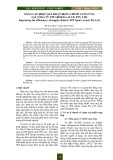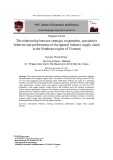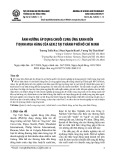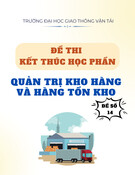
* Corresponding author
E-mail address: hoilq@neu.edu.vn (Q.H. Le)
© 2020 by the authors; licensee Growing Science.
doi: 10.5267/j.uscm.2019.11.003
Uncertain Supply Chain Management 8 (2020) 371–378
Contents lists available at GrowingScience
Uncertain Supply Chain Management
home
p
a
g
e: www.Growin
g
Science.com/usc
m
Green supply chain management practices and destination image: Evidence from Vietnam
tourism industry
Anh Duc Doa, Quang Vinh Nguyenb, Duy Uan Nguyenc, Quoc Hoi Led* and Dinh Uyen Trinhe
aVNU University of Economics and Business, Vietnam National University, Vietnam
bHanoi University of Business and Technology, Vietnam
cAsia E University, Malaysia
dNational Economics University, Vietnam
eTrung Vuong University, Vietnam
C H R O N I C L E A B S T R A C T
Article history:
Received October 20, 2019
Received in revised format
November 14, 2019
Accepted November 14 2019
Available online
November 14 2019
Vietnam is one of the most popular tourist destinations in the Asia-Pacific region and its
tourism industry has been growing unprecedentedly over the past few years. However, the
Vietnamese tourism industry (VTI) is concerned with the weakness competitive factor. This
paper aims to analyze Green Supply Chain Management Practice (GSCM) and its effect on the
destination image of Vietnam as the way to improve the completeness. The paper seeks to
examine internal environment management (IEM) practices; external environment (EE) and
environmental regulation (ER), as possible drivers to GSCM practices and its destination
image. The empirical analysis used data from 269 questionnaires which were valid for analysis,
through applying the PLS- SEM method. The result of path analysis indicates that the path
between internal environmental management and GSCM practice in the VTI was highly
significant; internal environmental management (IEM) had a significant impact on the external
environment and also had a significant impact on destination image in VTI. The external
environment has also maintained a significant impact on the GSCM practices of the VTI and
on destination image in VTI. There is also a positive relationship between GSCM and
destination image in VTI. As a result, it can be concluded that all hypotheses are supported.
This paper concludes with a discussion of the implications of the findings from the study for
tourism managers.
.Canadalicense Growin
g
Science, 2020 b
y
the authors; ©
Keywords:
Green supply chain
management
Tourism industry
Destination image
PLS- SEM
Vietnam
1. Introduction
Since there are many problems in exploring the tourism resource and the traditional supply chain cannot
meet the international quality standard, and some related technologies are not available in Vietnam,
there is a need for implementing Green Supply Chain Management Practice (GSCM). Sustainability
issues have been receiving an increasing attention from both practitioners and researchers in the
hospitality industry in recent years (Berezan et al., 2013). One of the reasons for this increase is that an
increasing number of travelers pay close attention to sustainability actions of companies (U.S. Travel
Association, 2009) and hold positive attitudes toward companies implementing sustainable actions (Xu
& Gursoy, 2015). In considering why tourist companies should use green supply chains, a series of
studies argue that compliance with regulations is a major driver that contributes to the implementation
of green supply chains (An et al., 2008; Dam, 2017). Ho et al. (2009) suggest that some of these

372
organizations are enhancing their competitiveness through improvements in their environmental
performance to comply with mounting environmental regulations, to address the environmental
concerns of their customers, and to mitigate the environmental impact of their production and service
activities. Competition in the global market is becoming increasingly fierce pressure to the tourism
industry, forcing them to cut costs, improve product quality, together with the increased level of
customer service (Tseng, 2010). Also, the study suggests that sustainability practices have become
significant determinants of customer loyalty and improving the destination image.
Vietnam has a long coastline, beautiful natural scenery and a culture of rich identity. These are great
advantages for tourism to become the key economic sector of the country. 2017 is considered the
impressive development of tourism in Vietnam with the highest number of international visitors with
nearly 30% increase compared with 2016. During the year of 2018, the number of tourists and total
revenue from tourists continued to grow strongly at 15.6 million international visitors (2.6 million more
visitors compared with 2017), and total revenue from tourists reached more than VND 620,000 billion.
The tourism industry creates a great potential and it has achieved initial results and there is still bigger
potentials and expectations for Vietnam society. Nguyen (2010) concludes that, many Vietnam tourism
companies find it hard to evaluate their own competitiveness, resulting in their inability to seek
effective solutions to enhance it. In order to help receive more foreign visitors to Vietnam, there is a
need to do some scientific works on competitiveness evaluation of Vietnam Tourism Industry (VTI)
under GSCM approach. Managing the supply chain is the fusion of travel and business process mainly
from the initial suppliers (goods, travel services) to final users (tourists) to provide the product, services
and information to create added value for business travelers and tourists. The creation and supply chain
management efficient tourism will help optimize the benefits for stakeholders (suppliers, tourists and
locals). At the same time, it contributes to the development of Vietnam tourism and building strong and
sustainable future (Vinh et al., 2015). The field of supply chain management has more recently directed
its attention to the role of the supply chain in both (a) impacts to the natural environment and (b) the
generation of environmental performance change. Since most of the goods and services included in a
holiday package are provided by a supply chain of subcontracted companies, organizations and agents,
hotel managers are not always in direct control of the environmental and social impacts of those
products (Zhang et al., 2009). Consumers increasingly expect the companies that they purchase goods
to ensure not only the quality and value-for-money, but also the safeguard environmental and social
sustainability (Vinh et al., 2015). Besides, many studies have indicated that both the environmental and
economic dimensions have positive influences on customer satisfaction and destination image.
However previous studies still provide limited findings about the positive impact of GSCM in tourism
on destination image (Jang et al., 2015; Xu & Gursoy, 2015; Berezan et al., 2013 Lee et al., 2010).
Thus, this study is timely and necessary to better aid VTI in the GSCM principles. The main objectives
of this study are to analyze the relationship between green supply chain management practice and
destination image.
2. Literature Review
In recent years, the phrase “green supply chain” has been mentioned more frequently. Concerning it,
many terms have been used as “sustainable supply chain”, “sustainable green supply chain”,
“environmental supply chain”, “ecological supply chain”. Beamon (1999) emphasized the importance
of cooperating with a company and defining green supply chain management by using the supply chain
between a central company and a cooperative company, to support organizations, ecological
management know-how in the central companies and the development of clean production techniques.
Sarkis (2012) also defines green supply chain management as a combination of a revamped
environmental and logistics company, which emphasizes the importance of reverse logistic. So green
supply chain management is the process of adding “green” elements to existing supply chains and
creating a recalled supply chain as a rebuilding system in a bright way. This includes not only effective
pursuit, but also innovation in the supply chain related to costs, profits, and the environment. To ensure

A.D. Do et al. /Uncertain Supply Chain Management 8 (2020)
373
environmental excellence, top management must be totally committed. Carter et al. (1998) concluded
that support from middle managers is also essential to the successful implementation of GSCM
practices. Bowen et al. (2001) used middle-level managers to find positive relationships between
middle-level managers’ perceptions of corporate environmental proactivity and environmental
management. Communication between business managers and environmental professionals is also
important in a successful business and environmental relationship. Chien and Shih (2007) asserted that
it is important to evaluate the performance of GSCM inside the organization. Environmental
performance is commonly measured through operative performance indicators and management
performance indicators (Cagno et al., 2011). Moreover, for hotels that pay special attention to the
performance of GSCM, internal environmental management (IEM) is more influential in stressing
GSCM. Lin (2011, p.2) stated that “due to customer demands for green products which are
manufactured using environmentally friendly raw materials and green production processes, firms have
to integrate its environmental goals with long-term strategic management”. Consumer pressure
certainly stimulates the environmental performance of other industries, notably the high-street hotel
industry (Phan, 2019). While the growth of boutique eco-hotels suggests a growing clientele for such
services, all organizations in the hotel industry must ensure the sustainability of all the components of
their products (Sigala, 2008). Whereas first-time guests usually choose their hotels based on location,
amenities and services, returning customers may base their decisions on the level of environmental
commitment.
Literature shows that all suppliers need to cooperate and translate sustainability policies and metrics
into actionable, sustainable goals, the current and future performance levels of which can be traced and
monitored. Vachon and Klassen (2008), Nguyen (2010) and Sundarakani et al. (2010) argued that
technology and innovation, transparency and the enhancement of supplier relationships are important
factors in the management of green supply chains, though there are many factors that should be
considered in green supply chain management. According to the theories mentioned above, the
relationship with suppliers is the most important factor for GSCM. Further, Ho et al. (2009) also
indicated that building a good relationship with suppliers can benefit both parties when they work
together to improve product design and product efficiency, which can lead to more waste reduction.
Zhu et al. (2008) conclude that the success of eco-design requires internal, cross-functional cooperation
within the company and external cooperation with other partners throughout the supply chain.
According to Vachon and Klassen (2006), it is better for corporations to establish long-term
relationships with suppliers, which includes establishing requirements for product quality, following
environmental regulations at the manufacturing level, having green packaging and distribution
strategies and delivering high-quality products to customers (Xu & Gursoy, 2015). The discussion
above leads to the second hypothesis. In considering why firms use green supply chains, a series of
studies argue that compliance with regulations is a major driver that contributes to the implementation
of green supply chains (An et al., 2008). Zhu and Sarkis (2006) divide the regulatory environment into
three levels: regional environmental regulations, central government environmental regulations, and
international environmental regulation agreements. To balance rapid economic growth, rapidly
improving hotel service quality and environmental impact, the government of Vietnam must introduce
certain policies and regulations to facilitate the development of sustainability (Lai & Vinh, 2013).
According to Cater and Rogers (2008), sustainability involves three components: environmental, social
and economic performance. Although governments aim to perform well in all areas, they pay the most
attention to regulating environmental issues. To slow environmental degradation, sustainability is
advocated (Jang et al., 2015). In considering this issue, developed countries took several measures,
such as publishing certain laws and standards to control environmental impacts (Xu & Gursoy, 2015).
However, in developing countries such as Vietnam, sustainability is still a new topic. Policies and
approaches related to sustainability are incomplete, and the development of sustainability is at an early
stage (Lai & Vinh, 2012). As concluded by Ling (2015) “The concept of sustainable development is
the inevitable choice of supply chains management. For tourism industry, all the enterprises in the
supply chains should be responsible for travel resources protection and long-term development

374
coordination”. Based on the perspective of sustainable development supply chain, a number of
optimization strategies are suggested for green consumption in this paper, which includes tourism
resources development and design, daily operation management, product marketing and culture
promotion. Besides, these practices can further examine the research in the future and improve
H1: Internal environmental management (IEM) has a significant impact on GSCM practice in the VTI.
H2: Internal environmental management (IEM) has a significant impact on the external environment.
H3: Internal environmental management (IEM) has a significant impact on destination image in VTI.
H4: The external environment has a significant impact on the GSCM practices of the VTI.
H5: The external environment has a significant impact on destination image in VTI.
H6: There is positive relationship between GSCM and destination image in VTI.
Fig. 1. Research model
3. Methodology
Based on literature discussed above, the technique for creation of attributes for this thesis is based on
literature review, pilot sample, researcher’s judgment and experts. The structured questionnaire is
employed. The communication approaches selected are both “survey via personal interview” and “self-
administered survey”. For this study, we have chosen the form of interview as a method to collect data.
Our goal is to collect 400 samples of survey questions from different units of tourist companies and
hotels in the northern of Vietnam. This study uses a survey questionnaire to elicit perceptions/opinions
about GSCM from managers in the VTI. The survey instrument includes questions seeking
demographic information. The questionnaires were mailed to managers working in tourism industry in
northern of Vietnam. The SPSS 20.0 and PLS-SEM 3.0 software were applied to analyze and verify
the gathered data and the hypothesis developed. This study reviews scholars' literature based on the
research and practice of GSCM, the appropriate measurement scales of Zhu et al. (2008), Chen et al.
(2011), and Diabat and Govindan (2011) and information gathered from expert interviews. The
destination image is developed by author with three items include “Tourist have a positive opinion
about this green tourist destination. This tourist destination has a unique image and becoming popular
related to green product and This tourist destination respects the natural environment”. In the literatures,
destination image research is mostly conducted with current or potential tourists however, according to
Dunn (2005, p. 80), conducted survey with the supplier and it is an excellent method of gaining access
to information and collecting a diversity of opinions and experiences. The following suggestions and
recommendations outlined by Dunn (2005, pp. 79-105) were taken into consideration and provided a
valuable basis for the conduction of the survey. The questionnaire was distributed firstly to 30 managers
to check how they understand the questions. Afterward, questionnaire was revised to become the final
version and ready for collecting data. There are 316 questionnaires distributed to staffs and managers
who were working in hotels and travel companies. 280 questionnaires were sent back to authors in
which 269 ones were valid for analysis which represents 64%. Table 1 shows the respondent
information.

A.D. Do et al. /Uncertain Supply Chain Management 8 (2020)
375
Table 1
Respondent information
Frequency Percent Frequency Percent
Gender Male 174 64.7 USA 51 19.0
Female 95 35.3 China 55 20.4
Experience < 5 yea
r
17 6.3 Market EU 37 13.8
5 - 10 yea
r
50 18.6 ASEAN 31 11.5
11-15 yea
r
118 43.9 Asia 39 14.5
>15 yea
r
84 31.2 Others 56 20.8
Age <25-yea
r
-ol
d
42 15.6 Hotels 134 49.8
26 - 35-yea
r
-ol
d
114 42.4 Business type Travel 66 24.5
36 - 45-yea
r
-ol
d
85 31.6 Destination 69 25.7
> 45-yea
r
-ol
d
28 10.4 Total 269 100.0 Total
4. Data analysis
4.1 Reliability and Validity of Model
Construct validity, determined through the presence of convergent and discriminant validity,
demonstrates how well the measurement items relate to the constructs. To demonstrate convergent
validity, we have used three tests: item reliability, composite reliability, and average variance extracted.
Cronbach’s alphas also provide evidence of composite reliability and values above 0.6 demonstrate
that they are adequate. All the composite reliabilities for our constructs were above 0.7 and all the
Cronbach’s alphas were above 0.6 (see Table 2). Finally, the average variance extracted (AVE)
represented the amount of variance a construct captures via its items relative to the amount of variation
due to measurement error. We have found that each construct’s variance extracted was above the
recommended value of 0.5.
Table 2
Construct Reliability and Validity
Cronbach's
Alpha rho A Composite
Reliability
Average Variance Extracted
(AVE)
Destination Ima
g
e 0.805 0.844 0.816 0.604
External environmental 0.881 0.886 0.882 0.600
GSCM in VTI 0.884 0.891 0.885 0.721
Internal environmental mana
g
ement 0.898 0.901 0.898 0.638
Thus, we have concluded that all our constructs had satisfactory convergent validity. We have used two
tests for discriminant validity: comparison of item loadings with item cross loadings and comparison
of the variance extracted from the construct with shared variance. Each item should load more highly
on its intended construct than on other constructs. We have found that all our items satisfied this
condition (see Table 2).
Table 3
Convergent validity analysis
Destination
Image
External
environmental
GSCM in
VTI
Internal environmental
management
Destination Ima
g
e 0.777
External environmental 0.687 0.775
GSCM in VTI 0.612 0.691 0.849
Internal environmental mana
g
ement 0.688 0.749 0.673 0.799
4.2 PLS structural model results
We next examined the overall explanatory power of the structural model, the amount of variance
explained by the independent variables, and the magnitude and strength of its paths, where each of our

![Sổ tay Hướng dẫn phát triển chuỗi cung ứng [Chuẩn nhất]](https://cdn.tailieu.vn/images/document/thumbnail/2025/20251007/kimphuong1001/135x160/26201759828896.jpg)


![Tổng quan môn học Quản trị logistics kinh doanh: [Thông tin chi tiết/Hướng dẫn/Tài liệu]](https://cdn.tailieu.vn/images/document/thumbnail/2025/20250604/nganga_00/135x160/624_tong-quan-mon-hoc-quan-tri-logistics-kinh-doanh.jpg)






![Đề kiểm tra Quản trị logistics [mới nhất]](https://cdn.tailieu.vn/images/document/thumbnail/2025/20251015/2221002303@sv.ufm.edu.vn/135x160/35151760580355.jpg)
![Bộ câu hỏi thi vấn đáp Quản trị Logistics [năm hiện tại]](https://cdn.tailieu.vn/images/document/thumbnail/2025/20251014/baopn2005@gmail.com/135x160/40361760495274.jpg)













